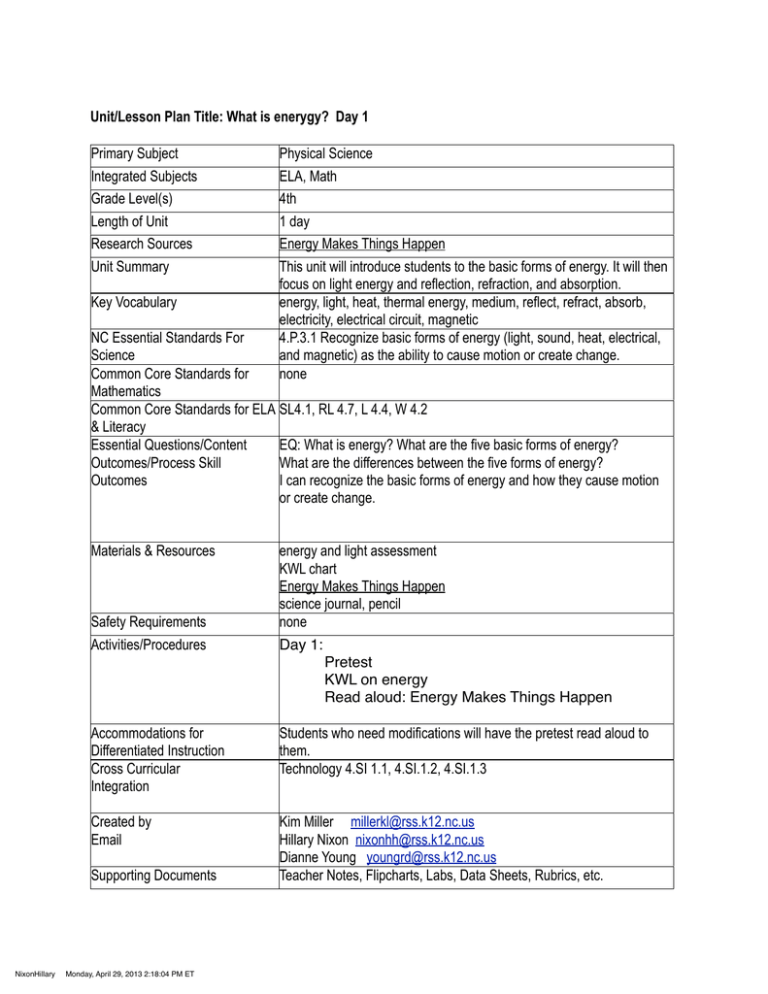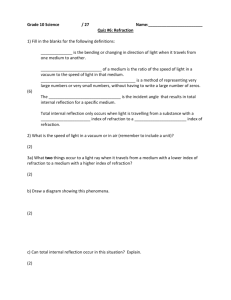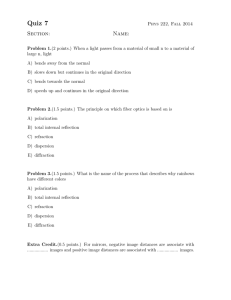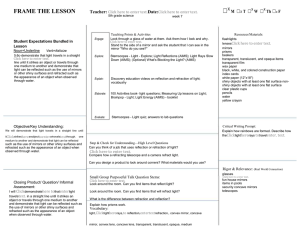Unit/Lesson Plan Title: What is enerygy? Day 1 Primary Subject
advertisement

Unit/Lesson Plan Title: What is enerygy? Day 1 Primary Subject Integrated Subjects Grade Level(s) Length of Unit Research Sources Unit Summary Key Vocabulary Physical Science ELA, Math 4th 1 day Energy Makes Things Happen This unit will introduce students to the basic forms of energy. It will then focus on light energy and reflection, refraction, and absorption. energy, light, heat, thermal energy, medium, reflect, refract, absorb, electricity, electrical circuit, magnetic 4.P.3.1 Recognize basic forms of energy (light, sound, heat, electrical, and magnetic) as the ability to cause motion or create change. none NC Essential Standards For Science Common Core Standards for Mathematics Common Core Standards for ELA SL4.1, RL 4.7, L 4.4, W 4.2 & Literacy Essential Questions/Content EQ: What is energy? What are the five basic forms of energy? Outcomes/Process Skill What are the differences between the five forms of energy? Outcomes I can recognize the basic forms of energy and how they cause motion or create change. Materials & Resources Safety Requirements Activities/Procedures Accommodations for Differentiated Instruction Cross Curricular Integration Students who need modifications will have the pretest read aloud to them. Technology 4.SI 1.1, 4.SI.1.2, 4.SI.1.3 Created by Email Kim Miller millerkl@rss.k12.nc.us Hillary Nixon nixonhh@rss.k12.nc.us Dianne Young youngrd@rss.k12.nc.us Teacher Notes, Flipcharts, Labs, Data Sheets, Rubrics, etc. Supporting Documents NixonHillary energy and light assessment KWL chart Energy Makes Things Happen science journal, pencil none Day 1: ! Pretest ! KWL on energy ! Read aloud: Energy Makes Things Happen Monday, April 29, 2013 2:18:04 PM ET Unit/Lesson Plan Title: What is enerygy? Day 2 & 3 Primary Subject Integrated Subjects Grade Level(s) Physical Science ELA, Math 4th Length of Unit Research Sources Unit Summary 2 days studyjams.com, http://www.eia.gov/kids/, ActivInspire flipchart This unit will introduce students to the basic forms of energy. It will then focus on light energy and reflection, refraction, and absorption. energy, light, heat, thermal energy, medium, reflect, refract, absorb, electricity, electrical circuit, magnetic 4.P.3.1 Recognize basic forms of energy (light, sound, heat, electrical, and magnetic) as the ability to cause motion or create change. none Key Vocabulary NC Essential Standards For Science Common Core Standards for Mathematics Common Core Standards for ELA L 4.4, RL 4.7, SL 4.1 & 4.2, W 4.2, RI 4.4, 4.5, 4.6, 4.7, 4.9 & Literacy Essential Questions/Content EQ: What is energy? What are the five basic forms of energy? Outcomes/Process Skill What are the differences between the five forms of energy? Outcomes I can recognize the basic forms of energy and how they cause motion or create change. EQ: How does light travel? I can recognize that light travels in a straight line. EQ: Why does the direction in which light travels change? What is refraction, reflection, and absorption? I can understand that light changed by refraction, reflection, and absorption. NixonHillary Materials & Resources KWL chart, vocabulary flipchart, energy flipchart, study guide, video/ computer (Study Jams), projector, screen, exit slip, pencil Safety Requirements none Monday, April 29, 2013 2:18:04 PM ET Activities/Procedures Accommodations for Differentiated Instruction Cross Curricular Integration Created by Email Supporting Documents NixonHillary Monday, April 29, 2013 2:18:04 PM ET Day 2 & 3 -Review KWL chart created on Day 1 -Key Vocabulary FlipChart (energy, heat, thermal energy, electrical circuit, light, medium, electricity, magnetic) -Energy Video-Study Jams: Heat, Sound, Light, Electrical, Magnetic -Complete a study guide for the videos on study jam -Go over study guides -Review Energy FlipChart (from Anna) -Exit slip: students will write on an index card/ sticky note one thing they learned today Some students will be able to tell one thing they learned rather than writing it out. Technology 4.SI.1.1, 4.SI.1.2, 4.SI.1.3 Kim Miller millerkl@rss.k12.nc.us Hillary Nixon nixonhh@rss.k12.nc.us Dianne Young youngrd@rss.k12.nc.us Teacher Notes, Flipcharts, Labs, Data Sheets, Rubrics, etc. Unit/Lesson Plan Title: What is light and how does it travel? Day 4 Primary Subject Integrated Subjects Grade Level(s) Physical Science ELA, Math 4th Length of Unit Research Sources Unit Summary 1 day http://www.eia.gov/kids/, www.neok12.com, This unit will introduce students to the basic forms of energy. It will then focus on light energy and reflection, refraction, and absorption. energy, light, heat, thermal energy, medium, reflect, refract, absorb, electricity, electrical circuit, magnetic 4.P.3.2 Recognize that light travels in a straight line until it strikes an object or travels from one medium to another, and that light can be reflected, refracted, and absorbed. none Key Vocabulary NC Essential Standards For Science Common Core Standards for Mathematics Common Core Standards for ELA SL 4.1, 4.2, W 4.2, RI 4.3, 4.4, 4.5, 4.6, 4.7, 4.9, RL 4.7 & Literacy Essential Questions/Content EQ: How does light travel? Outcomes/Process Skill I can recognize that light travels in a straight line. Outcomes EQ: Why does the direction in which light travels change? What is refraction, reflection, and absorption? I can understand that light changed by refraction, reflection, and absorption. Materials & Resources computer/video (www.neok12.com), projector, screen, study guide, lab materials: Styrofoam cup w/bottom -Styrofoam cup w/o bottom -Pinhole Viewer Lab Sheet -Black construction paper circle cutout -Black construction paper crescent cutout -4” x 4” wax paper cutout -Sharpened pencil -Scotch tape -Flashlight exit slip Safety Requirements Activities/Procedures NixonHillary Monday, April 29, 2013 2:18:04 PM ET Use materials carefully following safety rules. Day 4 -Briefly Review -Introduce light: Video: The Science of Light- www.neok12.com -Exploration: Pinhole Viewer -Exit Slip: Complete the Sources and Straight Lines handout Accommodations for Differentiated Instruction Cross Curricular Integration Created by Email Supporting Documents NixonHillary Monday, April 29, 2013 2:18:04 PM ET Students who need to will be paired with another student to help complete their exit slip Technology: 4.SI.1.1, 4.SI.1.2, 4.SI.1.3 Kim Miller millerkl@rss.k12.nc.us Hillary Nixon nixonhh@rss.k12.nc.us Dianne Young youngrd@rss.k12.nc.us Teacher Notes, Flipcharts, Labs, Data Sheets, Rubrics, etc. Unit/Lesson Plan Title: What is light and how does it travel? Day 5 & 6 Primary Subject Integrated Subjects Grade Level(s) Physical Science ELA, Math 4th Length of Unit Research Sources Unit Summary 2 days http://www.eia.gov/kids/, www.studyjams.com This unit will introduce students to the basic forms of energy. It will then focus on light energy and reflection, refraction, and absorption. energy, light, heat, thermal energy, medium, reflect, refract, absorb, electricity, electrical circuit, magnetic 4.P.3.2 Recognize that light travels in a straight line until it strikes an object or travels from one medium to another, and that light can be reflected, refracted, and absorbed. none Key Vocabulary NC Essential Standards For Science Common Core Standards for Mathematics Common Core Standards for ELA SL 4.1, 4.2, W 4.2, RI 4.4, 4.5, 4.6, 4.7, 4.9, RL 4.7 & Literacy Essential Questions/Content EQ: How does light travel? Outcomes/Process Skill I can recognize that light travels in a straight line. Outcomes EQ: Why does the direction in which light travels change? What is refraction, reflection, and absorption? I can understand that light changed by refraction, reflection, and absorption. Materials & Resources computer/video (Study Jams), projector, screen, study guide, pencil Safety Requirements Activities/Procedures none Day 5 & 6 -Review Forms of Energy -Using Study Jams: Light Absorption, Refraction and Reflection to introduce energy transfer Accommodations for Differentiated Instruction Cross Curricular Integration Created by Email Student may complete study guide with a partner. Supporting Documents NixonHillary Monday, April 29, 2013 2:18:04 PM ET Technology: 4.SI.1.1, 1.2, 1.3 Kim Miller millerkl@rss.k12.nc.us Hillary Nixon nixonhh@rss.k12.nc.us Dianne Young youngrd@rss.k12.nc.us Teacher Notes, Flipcharts, Labs, Data Sheets, Rubrics, etc. Unit/Lesson Plan Title: What is reflection? Day 7 & 8 Primary Subject Integrated Subjects Grade Level(s) Physical Science ELA, Math 4th Length of Unit Research Sources Unit Summary 2 days http://www.eia.gov/kids/, www.neok12.com This unit will introduce students to the basic forms of energy. It will then focus on light energy and reflection, refraction, and absorption. energy, light, heat, thermal energy, medium, reflect, refract, absorb, electricity, electrical circuit, magnetic 4.P.3.2 Recognize that light travels in a straight line until it strikes an object or travels from one medium to another, and that light can be reflected, refracted, and absorbed. 4 NBT 1,2,3,4 4 NF 6,7 4 MD 1,2,4 Key Vocabulary NC Essential Standards For Science Common Core Standards for Mathematics Common Core Standards for ELA SL 4.1, 4.2 W 4.2 RI 4.3, 4.4, 4.5, 4.6, 4.7, 4.9 RL 4.7 & Literacy Essential Questions/Content EQ: How does light travel? Outcomes/Process Skill I can recognize that light travels in a straight line. Outcomes EQ: Why does the direction in which light travels change? What is refraction, reflection, and absorption? I can understand that light changed by refraction, reflection, and absorption. Materials & Resources computer/video, projector, screen, Vernier LabQuest, light probe, white paper, black paper, 2 different colored papers, pencil, tape, ruler, Lab notebook, journal Safety Requirements Use care with equipment following safety rules. Activities/Procedures Day 7 & 8 -Review -Introduce Reflection -Video: Reflection-neok12.com -Exploration-Reflectivity of Light-Vernier LabQuest -Complete Lab Notebook: Reflectivity of Light section -Journal about discoveries on the reflection of light Accommodations for -Students may draw an illustration about their discoveries with Differentiated Instruction reflections Cross Curricular Technology: 4.SI.1.1, 4.SI.1.2, 4.SI.1.3 Integration Created by Kim Miller millerkl@rss.k12.nc.us Email Hillary Nixon nixonhh@rss.k12.nc.us Dianne Young youngrd@rss.k12.nc.us Supporting Documents Teacher Notes, Flipcharts, Labs, Data Sheets, Rubrics, etc. NixonHillary Monday, April 29, 2013 2:18:04 PM ET Unit/Lesson Plan Title: What is refraction? Day 9 & 10 Primary Subject Physical Science Integrated Subjects ELA, Math Grade Level(s) 4th Length of Unit Research Sources Unit Summary Key Vocabulary NC Essential Standards For Science 2 days http://www.eia.gov/kids/, www.neok12.com This unit will introduce students to the basic forms of energy. It will then focus on light energy and reflection, refraction, and absorption. energy, light, heat, thermal energy, medium, reflect, refract, absorb, electricity, electrical circuit, magnetic 4.P.3.2 Recognize that light travels in a straight line until it strikes an object or travels from one medium to another, and that light can be reflected, refracted, and absorbed. none Common Core Standards for Mathematics Common Core Standards for ELA SL 4.1, 4.2 W 4.2 RI 4.3, 4.4, 4.5, 4.6, 4.7, 4.9 RL 4.7 & Literacy Essential Questions/Content EQ: How does light travel? Outcomes/Process Skill I can recognize that light travels in a straight line. Outcomes EQ: Why does the direction in which light travels change? What is refraction, reflection, and absorption? I can understand that light changed by refraction, reflection, and absorption. Materials & Resources computer/video, projector, screen, Lab notebook, journal, pencil, Lab Materials:(per student) 2 clear cups, water, milk, flashlight, 5 straws Safety Requirements Do not shine flashlight directly into others’ eyes. Activities/Procedures Day 9 & 10 -Review -Introduce Refraction -Video: Refraction-neok12.com -Exploration-The Path of Light -Complete Lab Notebook: Path of Light section -Journal about discoveries on the refraction of light Accommodations for -Students may draw an illustration about their discoveries with Differentiated Instruction refractions Cross Curricular Technology: 4.SI.1.1, 4.SI.1.2, 4.SI.1.3 Integration Created by Kim Miller millerkl@rss.k12.nc.us Email Hillary Nixon nixonhh@rss.k12.nc.us Dianne Young youngrd@rss.k12.nc.us Supporting Documents Teacher Notes, Flipcharts, Labs, Data Sheets, Rubrics, etc. NixonHillary Monday, April 29, 2013 2:18:04 PM ET Unit/Lesson Plan Title: What is absoprtion? Day 11 & 12 Primary Subject Integrated Subjects Grade Level(s) Physical Science ELA, Math 4th Length of Unit Research Sources Unit Summary 2 days http://www.eia.gov/kids/, This unit will introduce students to the basic forms of energy. It will then focus on light energy and reflection, refraction, and absorption. energy, light, heat, thermal energy, medium, reflect, refract, absorb, electricity, electrical circuit, magnetic 4.P.3.2 Recognize that light travels in a straight line until it strikes an object or travels from one medium to another, and that light can be reflected, refracted, and absorbed. 4 NBT.1, NBT.2, NBT.3, NBT.4, 4.NF.6, NF.7, 4MD.1, MD.2, MD.4 Key Vocabulary NC Essential Standards For Science Common Core Standards for Mathematics Common Core Standards for ELA W 4.2, SL 4.1, 4.2, RI 4.3, 4.5, 4.6, 4.7 & Literacy Essential Questions/Content EQ: How does light travel? Outcomes/Process Skill I can recognize that light travels in a straight line. Outcomes EQ: Why does the direction in which light travels change? What is refraction, reflection, and absorption? I can understand that light changed by refraction, reflection, and absorption. Materials & Resources Lab materials: Vernier LabQuest, light probe, at least 3 types of fabric swatches in black and white, Lab notebook, journal, pencil Safety Requirements Activities/Procedures Accommodations for Differentiated Instruction Cross Curricular Integration Created by Email Supporting Documents NixonHillary Monday, April 29, 2013 2:18:04 PM ET Use safety rules with the lab equipment. Day 11 & 12 -Review -Introduce Absorption -Exploration-Sunshine on My Shoulders-Vernier Labquest -Complete Lab Notebook: Sunshine on My Shoulders section -Journal about findings during their exploration with the absorption of light -Students may draw an illustration about their discoveries with absorption 4TT.1.1, 1.2, 1.3 Kim Miller millerkl@rss.k12.nc.us Hillary Nixon nixonhh@rss.k12.nc.us Dianne Young youngrd@rss.k12.nc.us Teacher Notes, Flipcharts, Labs, Data Sheets, Rubrics, etc. Unit/Lesson Plan Title: Unit Review Day 13 & 14 Primary Subject Physical Science Integrated Subjects ELA, Math Grade Level(s) 4th Length of Unit Research Sources Unit Summary Key Vocabulary NC Essential Standards For Science 2 days http://www.eia.gov/kids/, Energy Scavenger Hunt, ActivInspire flipchart This unit will introduce students to the basic forms of energy. It will then focus on light energy and reflection, refraction, and absorption. energy, light, heat, thermal energy, medium, reflect, refract, absorb, electricity, electrical circuit, magnetic 4.P.3.1 Recognize basic forms of energy (light, sound, heat, electrical, and magnetic) as the ability to cause motion or create change. 4.P.3.2 Recognize that light travels in a straight line until it strikes an object or travels from one medium to another, and that light can be reflected, refracted, and absorbed. none Common Core Standards for Mathematics Common Core Standards for ELA W 4.2, RI 4.1, 4.3, 4.4, 4.7, SL 4.1, 4.2 & Literacy Essential Questions/Content EQ: What is energy? What are the five basic forms of energy? Outcomes/Process Skill What are the differences between the five forms of energy? Outcomes I can recognize the basic forms of energy and how they cause motion or create change. EQ: How does light travel? I can recognize that light travels in a straight line. EQ: Why does the direction in which light travels change? What is refraction, reflection, and absorption? I can understand that light changed by refraction, reflection, and absorption. Materials & Resources computer, energy flipchart, computer for each student, copy of scavenger hunt for each student, pencil, journal Safety Requirements none Activities/Procedures Day 13 & 14 -Review Energy Flipchart -Energy Kids Scavenger Hunt -Journal writing refelecting on scavenger hunt for the day Accommodations for Students may work with a partner. Differentiated Instruction Cross Curricular Technology: 4.SI 1.1, 1.2, 1.3, 4.TT.1.1, 4.RP.1.1 Integration NixonHillary Monday, April 29, 2013 2:18:04 PM ET Created by Email Supporting Documents NixonHillary Monday, April 29, 2013 2:18:04 PM ET Kim Miller millerkl@rss.k12.nc.us Hillary Nixon nixonhh@rss.k12.nc.us Dianne Young youngrd@rss.k12.nc.us Teacher Notes, Flipcharts, Labs, Data Sheets, Rubrics, etc. Unit/Lesson Plan Title: Unit Review Day 15 & 16 Primary Subject Physical Science Integrated Subjects ELA, Math Grade Level(s) 4th Length of Unit Research Sources Unit Summary Key Vocabulary NC Essential Standards For Science 2 days http://www.eia.gov/kids/, Keynote, Comic Life, iPhoto, iMovie This unit will introduce students to the basic forms of energy. It will then focus on light energy and reflection, refraction, and absorption. energy, light, heat, thermal energy, medium, reflect, refract, absorb, electricity, electrical circuit, magnetic 4.P.3.1 Recognize basic forms of energy (light, sound, heat, electrical, and magnetic) as the ability to cause motion or create change. 4.P.3.2 Recognize that light travels in a straight line until it strikes an object or travels from one medium to another, and that light can be reflected, refracted, and absorbed. none Common Core Standards for Mathematics Common Core Standards for ELA W 4.2, SL 4.1, 4.2, 4.4, 4.5, RI 4.3, 4.5, 4.7 RL 4.7, L 4.4 & Literacy Essential Questions/Content EQ: What is energy? What are the five basic forms of energy? Outcomes/Process Skill What are the differences between the five forms of energy? Outcomes I can recognize the basic forms of energy and how they cause motion or create change. EQ: How does light travel? I can recognize that light travels in a straight line. EQ: Why does the direction in which light travels change? What is refraction, reflection, and absorption? I can understand that light changed by refraction, reflection, and absorption. Materials & Resources computer for each student, lab notebook, pencil Safety Requirements Activities/Procedures Accommodations for Differentiated Instruction Cross Curricular Integration Created by Email Supporting Documents NixonHillary Monday, April 29, 2013 2:18:04 PM ET none Day 15 & 16 -Students will create a multimedia presentation using pictures and information collected throughout to conclude the unit Allow students to work with a partner and obtain assistance from teacher as needed. Technology: 4 SI 1.1, 1.2, 1.3 4 TT 1.1, 1.2, 1.3 4 RP 1.1 Kim Miller millerkl@rss.k12.nc.us Hillary Nixon nixonhh@rss.k12.nc.us Dianne Young youngrd@rss.k12.nc.us Teacher Notes, Flipcharts, Labs, Data Sheets, Rubrics, etc. Unit/Lesson Plan Title: Unit Review Day 18 & 19 Primary Subject Physical Science Integrated Subjects ELA, Math Grade Level(s) 4th Length of Unit Research Sources Unit Summary Key Vocabulary NC Essential Standards For Science 2 days http://www.eia.gov/kids/, Keynote, Comic Life, iPhoto, iMovie This unit will introduce students to the basic forms of energy. It will then focus on light energy and reflection, refraction, and absorption. energy, light, heat, thermal energy, medium, reflect, refract, absorb, electricity, electrical circuit, magnetic 4.P.3.1 Recognize basic forms of energy (light, sound, heat, electrical, and magnetic) as the ability to cause motion or create change. 4.P.3.2 Recognize that light travels in a straight line until it strikes an object or travels from one medium to another, and that light can be reflected, refracted, and absorbed. none Common Core Standards for Mathematics Common Core Standards for ELA W 4.2, SL 4.1, 4.2, 4.4, L 4.3, RI4.3 & Literacy Essential Questions/Content EQ: What is energy? What are the five basic forms of energy? Outcomes/Process Skill What are the differences between the five forms of energy? Outcomes I can recognize the basic forms of energy and how they cause motion or create change. EQ: How does light travel? I can recognize that light travels in a straight line. EQ: Why does the direction in which light travels change? What is refraction, reflection, and absorption? I can understand that light changed by refraction, reflection, and absorption. Materials & Resources energy and light assessment, pencil, computer, projector, screen Safety Requirements Activities/Procedures none Day 18 & 19 -Post-test -Group Presentations -Unit wrap up Accommodations for Differentiated Instruction Cross Curricular Integration Created by Email Students may present with a partner. Supporting Documents NixonHillary Monday, April 29, 2013 2:18:04 PM ET Technology: 4 TT 1.3 Kim Miller millerkl@rss.k12.nc.us Hillary Nixon nixonhh@rss.k12.nc.us Dianne Young youngrd@rss.k12.nc.us Teacher Notes, Flipcharts, Labs, Data Sheets, Rubrics, etc.



